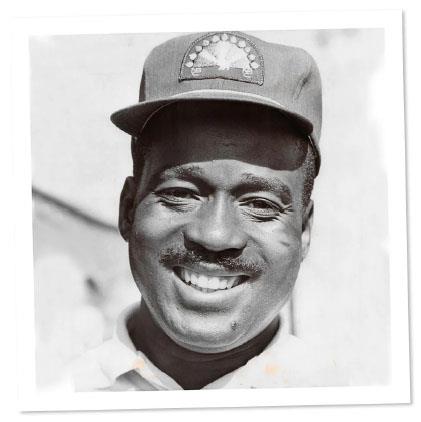 - In May 1964, golf history was made in remote Burneyville, Oklahoma at a PGA Tour event called the Waco Turner Open. The tournament ran from 1961 to 1964 at a venue then known only as “Waco Turner’s golf course,” and it combined professional golf with elements of the Wild West and Las Vegas prop betting. According to all accounts, the paucity of crowds at this event would not be seen again until the summer of 2020, when the PGA Tour resumed its schedule – without spectators – during the COVID-19 pandemic. It could well have been the strangest tour event ever staged. - In May 1964, golf history was made in remote Burneyville, Oklahoma at a PGA Tour event called the Waco Turner Open. The tournament ran from 1961 to 1964 at a venue then known only as “Waco Turner’s golf course,” and it combined professional golf with elements of the Wild West and Las Vegas prop betting. According to all accounts, the paucity of crowds at this event would not be seen again until the summer of 2020, when the PGA Tour resumed its schedule – without spectators – during the COVID-19 pandemic. It could well have been the strangest tour event ever staged.The main principals in 1964 were two nonwhite men, both born in Mississippi. One was the sponsor, Waco Turner, a member of the Chickasaw Nation. He was a wealthy, peculiar septuagenarian who carried pistols that he showed a willingness to use. The second was Pete Brown, a quiet, friendly sharecropper’s son who became the first Black golfer to win an official PGA Tour event. Waco Franklin Turner was born in 1891, in Holly Springs, Mississippi. As a boy, his family moved to Burneyville, Indian Territory. Like his father, Turner taught school. In 1917, after the United States declared war on the Axis nations, Turner joined the Army. According to a 1964 article in Sports Illustrated, he was introduced to golf while stationed at Fort Sam Houston during World War I, not as a player but when he caddied for an officer. While in the Army, Turner became a pilot, a skill that he would flaunt decades later during his tournament. 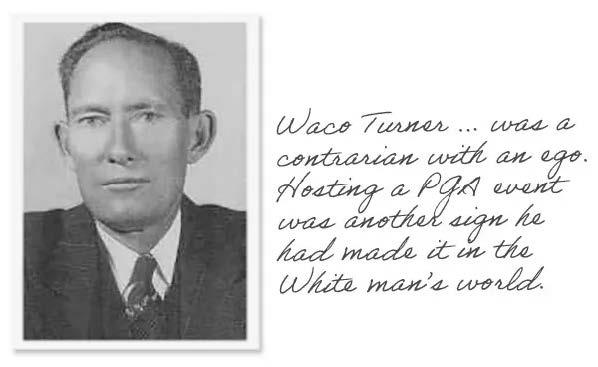 After the war, he returned to teaching in Ardmore, Oklahoma. Turner became friendly with wildcat speculators and in the early 1920s started to invest in oil wells. Enough of them were gushers to make Turner wealthy. He eventually amassed a fortune estimated at $40 million. He and his wife, Opie, became pillars of the Ardmore community and joined the Dornick Hills Golf Club where Turner was an enthusiastic but not accomplished golfer – on a good day he could break 90 – and he also served as president of the club. After the war, he returned to teaching in Ardmore, Oklahoma. Turner became friendly with wildcat speculators and in the early 1920s started to invest in oil wells. Enough of them were gushers to make Turner wealthy. He eventually amassed a fortune estimated at $40 million. He and his wife, Opie, became pillars of the Ardmore community and joined the Dornick Hills Golf Club where Turner was an enthusiastic but not accomplished golfer – on a good day he could break 90 – and he also served as president of the club.
After reaching age 60, Turner decided he wanted to promote professional golf. From 1952 to 1954, he sponsored a PGA Tour event, the Ardmore Open, at Dornick Hills. Ardmore had about 18,000 residents, with the nearest population centers being Dallas and Oklahoma City, both about 100 miles distant. Geography kept ticket sales low. Plus, all three years the Ardmore Open was slotted the same week as an unofficial event hosted by Sam Snead at the Greenbrier in West Virginia. Turner didn’t care. A short, thin man, he was a contrarian with an ego. Hosting a PGA event was another sign he had made it in the White man’s world. Turner put up his own money – more than that offered by Snead and many other events on the tour at the time. In 1952 at Turner’s tournament, Dave Douglas won one of his eight PGA Tour titles, and Earl Stewart won the following year. In 1954, while Snead and Ben Hogan played at the Greenbrier, Turner enticed his friend, the long-retired Byron Nelson, to play in Ardmore. Future World Golf Hall of Famer Julius Boros was victorious and took home $7,200. Turner also sponsored an LPGA Tour event at Ardmore in 1954, won by the legendary Patty Berg. After 1954, Turner had a falling-out with Dornick Hills and he discontinued the Ardmore tournaments. A few years later, he sold his oil holdings and retired to the 800-acre family farm in Burneyville that his father purchased in 1894. He constructed a lodge and built a golf course of his own design on the property (in 1970, the layout was redesigned by Robert Trent Jones, and operates today as the Falconhead Resort and Country Club). In 1958 and 1959, the new unnamed course hosted a LPGA event, the Opie Turner Open. Both years, it was won by immortals: Mickey Wright in 1958 and Betsy Rawls in 1959. The Turners decided to take another stab at running a men’s tournament. In 1961, Waco Turner accepted the PGA Tour’s offer of a date opposite the Tournament of Champions, which was held in Las Vegas. The TOC was open only to tour winners from the previous year and had no cut, so everybody took home at least $1,000 from the then-hefty $50,000 purse. Turner christened his event the Poor Boy’s Open as a nod to its non-select field. “As long as they have that tournament for the select few at Las Vegas, Opie and I will keep this one for the ‘have-nots,’” he said in 1961. (Opie would die in 1962 under mysterious circumstances; it was ruled a suicide.) Officially the PGA Tour called the Poor Boy’s Open the Waco Turner Open, which Turner minded not one bit. The fact the Poor Boy’s winner would be eligible for the following year’s TOC, guaranteeing that there never would be a repeat champion. A few of golf’s greats ventured to Burneyville. In 1961, Australian Peter Thomson, a future hall-of-famer and five-time Open Championship winner, made an appearance during a rare trip to America during his prime (he finished tied for seventh), and Nelson played as well. A young Jack Nicklaus entered in 1962 – the month before his maiden victory at the U.S. Open – and tied for third. Gay Brewer, who would win the 1967 Masters, took the 1963 Poor Boy’s Open.  “It was out in the middle of absolutely nowhere, near the little town of Ardmore,” former tour pro Chuck Courtney said. “It’s right there in what’s called the Arbuckle Hills, kind of the very, very beginning of the Ozarks. Anyway, just west of there is rolling country, ranches, and oil out there, not very many miles north of the Red River, which is the Oklahoma-Texas border.” “It was out in the middle of absolutely nowhere, near the little town of Ardmore,” former tour pro Chuck Courtney said. “It’s right there in what’s called the Arbuckle Hills, kind of the very, very beginning of the Ozarks. Anyway, just west of there is rolling country, ranches, and oil out there, not very many miles north of the Red River, which is the Oklahoma-Texas border.”
The layout was long for the time – about 7,100 yards – with a par of 73. It didn’t hearken visions of Augusta National or Pebble Beach. “The golf course, it looked like (Turner) laid out it out himself, with a few pretty good holes,” 1973 Masters champion Tommy Aaron mused recently. “Overall, the course wasn't much to talk about.” Although the modest purse of $20,000 was less than half of the TOC’s, the pros entering the Poor Boy’s Open were eligible to earn props not awarded anywhere else. Turner doled out $100 for the low round each day, $50 for an eagle, $25 for a chip-in, $15 for a birdie, and $500 for a hole-in-one. “That was unheard of at that time,” said former pro Bert Weaver in a 2022 interview shortly before his death. “Guys would do anything for a little more money.” Thus, if a player could manage two or three birdies per round, he at least could cover the cost of his caddie and lodging, even if he finished out of the money in the main purse. Turner did not charge admission. Still, few spectators showed up. “There was nobody there,” said Courtney, who played in the 1964 edition. As with the Ardmore Open, Turner did not care, as he held the Poor Boy’s Open for his own entertainment. He drove around the course in a tan Cadillac to follow the action, often on the fairway next to the competitors. Other times, Turner put his piloting skills to use. “He flew around in a little twin Cessna that would literally fly right down the fairway, 20 feet off the ground,” Courtney said. “I mean, it was crazy.” “He had his pistol and would shoot it out of the airplane,” Frank Beard recalled recently. “He was Crazy Waco Turner.” Beard tied for fifth in 1963 before winning later in the year to guarantee that he would never have to return to Burneyville. In 1964, while Nicklaus was winning the TOC over Arnold Palmer, Gary Player, Billy Casper and other winners from the previous year, a less select field played the Poor Boy’s Open. There were a few notables. Bruce Crampton was there; he won the Texas Open the week before, after the cut-off date for TOC eligibility. So were Aaron, Raymond Floyd, Dan Sikes and Miller Barber. **** Pete Brown also was at the 1964 Waco Turner. He was born in Port Gibson, Mississippi in 1935 to a family of sharecroppers. After moving to Jackson, he caddied at a local club and sneaked on to the course to play in the evening. Brown became adept enough to be hired by a successful Black businessman in Detroit to teach his family the game. At age 19, after he had moved to Detroit, he was stricken with polio and the weight on his 6-foot-1-inch frame dropped to 100 pounds. He recovered (eventually filling out to 200 pounds) and played in United Golf Association tournaments with other Black golfers, including Charlie Sifford, Lee Elder and Ted Rhodes. Brown won the Negro National Open in 1961 and 1962. At the 1962 Michigan Open – a non-PGA Tour event – Brown was tied after 72 holes with Tom Talkington. On the first hole of the sudden-death playoff, as Brown was about to tee off, a pickup truck pulled up along a fence and a young man yelled a racial slur before driving off. The spectators froze in mortified silence. Brown responded by tossing his club on the ground and laughing, which eased the tension and put the gallery in his corner. He went on to win on the third hole. “I’m a good driver but a terrible putter,” Brown said modestly after the win. “It’s the worst part of my game.” 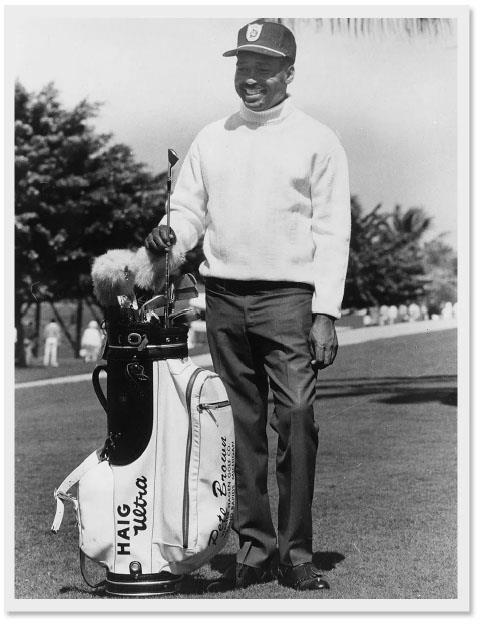 In 1961, the PGA of America removed a clause in its bylaws limiting membership to Caucasians, and the PGA Tour approved the applications of eligible Black pros. This did not mean they could play everywhere. “I can compete in only about 22 of the 48 tournaments a year,” Sifford said in 1961. “I can’t play in the Southern tournaments at Houston, Baton Rouge, New Orleans and Florida.” In 1961, the PGA of America removed a clause in its bylaws limiting membership to Caucasians, and the PGA Tour approved the applications of eligible Black pros. This did not mean they could play everywhere. “I can compete in only about 22 of the 48 tournaments a year,” Sifford said in 1961. “I can’t play in the Southern tournaments at Houston, Baton Rouge, New Orleans and Florida.”
Turner allowed Sifford and Brown to play at his club, though he didn’t always act like he welcomed their presence. According to a 1962 story in The Roanoke Times, one evening Sifford was playing poker and talking with fellow pros in the clubhouse. Turner walked up to him and pointed a loaded .45 pistol at his face. “Put that gun down,” Sifford said calmly. Turner did so, with an amused look that showed it was his idea of a joke. “He had Black caddies, and he didn’t like their kids hanging around,” Courtney said. “He actually got a gun out and started shooting in the ground with his pistol. ‘Get off the porch, you guys hanging out. I don’t want you here.’ Oh, he was a nutball.” Brown earned his tour card at the end of the 1963 season and played full-time in 1964, becoming the second Black, after Sifford, to compete regularly on the PGA Tour. If Sifford was golf’s Jackie Robinson, Brown was its Roy Campanella. Sifford, like Robinson, was unafraid to express his opinions and had an angry edge to him that many found off-putting: he was more admired than liked by his fellow pros. Brown, on the other hand, like Campanella, was by all accounts highly popular with his peers, and seemingly unbothered by any bigots whom he encountered. “Pete was really easygoing,” Courtney said. “He took all the racial slurs and bull----, and he kind of laughed and smiled and went his own way.” Courtney recalled playing a tense round with Sifford at the Greater Greensboro Open where Sifford was the target of abuse and understandably was upset. “Pete would have just waved at them and smiled,” Courtney said. Early in 1964, Brown made enough cuts to keep his head above water, including a tie for 27th at Doral in Florida (where he and Sifford were allowed to play) that netted him $525. At the Waco Turner, Weaver led after one round with 67, earning $100 for low round plus $95 for his eagle and three birdies. Floyd and Sikes were two back with 69s. Sifford shot 70, Brown 71. In the second round, Clyde “Moon” Mullins led Sikes by one, Sifford by two and Brown by four. On Saturday, Sifford and Brown fired 68s that left them one behind leader Dudley Wysong Jr. In the final round, Brown took the lead by one over Sifford after a front-nine 35. However, Sikes rallied with a 67 to take the clubhouse lead, finishing his round by chipping in for a birdie on the 232-yard par-3 18th hole. Brown arrived at the 18th still clinging to a one-shot lead. He hit his tee shot over the green and his ball came to rest in a rocky area. Upon seeing his lie, he later admitted to being nervous, but hit a wonderful chip to within 30 inches. Brown sank the putt for a final-round 70 to take first-prize money of $2,700 plus $340 in extras. Sifford faded, shooting 73 to tie for sixth. 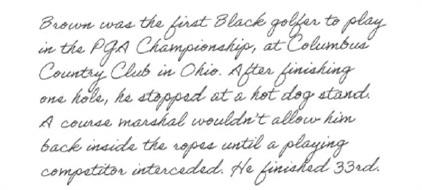 Previously, Sifford won the 1957 Long Beach Open (a 54-hole event over a field that included Billy Casper, Gene Littler and Jerry Barber) and the 1963 Puerto Rico Open, which were sponsored by the PGA Tour but were not official events. Brown’s win was the first by a Black golfer in an official PGA tournament. Not until Sifford’s win at the 1967 Greater Hartford Open would a Black player win a full-field PGA tournament. Immediately after his win, Brown was extended – and accepted – an invitation to become the first Black golfer to play in the following week’s Colonial National Invitational in Fort Worth. Brown said afterwards that he was “proud” of the honor but “scared to death.” Turner told him that he would help. “He wore two guns,” Brown told Bucky Albers of the Dayton Daily News in 1997. “He said, ‘If they give you any trouble, I’ll escort you around.’” In the first round at Colonial, Brown was paired with Bob Goalby. Brown said there were hecklers on the first tee, but Goalby made him feel at ease. “You play,” Goalby told him. “I’ll take care of these people.” Brown finished 12th to take home $1,620. Later in 1964, Brown was the first Black golfer to play in the PGA Championship, at Columbus Country Club in Ohio. After finishing one hole, he stopped at a hot dog stand. A course marshal wouldn’t allow him back inside the ropes until a playing competitor interceded. He finished 33rd. In August, Brown played the Carling World Open at Oakland Hills. It had all of the trappings of a major championship, with a stellar international field that included almost every player of note, with a rare appearance by Hogan. CBS expanded its coverage to six holes, and even had a 30-minute preview show on Friday night. Hogan had introduced himself to Brown at the Colonial and had taken a liking to him. Sports Illustrated reported that at Oakland Hills, Brown excitedly told fellow pros in the grill room that the taciturn Hogan had just said “Hi, Pete” to him. Brown tied Hogan for fourth place, four shots behind winner Bobby Nichols (Palmer finished second, Player third) to take home $6,850. It was the first time a Black pro was prominently featured in a nationally televised tournament. Late in the year, he lost to Billy Casper in a sudden-death playoff at the Almaden Open. **** The 1964 Waco Turner Open proved to be the last. In December 1964, it was announced the tournament would be discontinued. The PGA Tour was becoming more corporate, and a small-fry event hosted by an eccentric geezer, held in a remote location before few spectators, was not consistent with the image that the tour wanted to project. The tour recommended to Turner that his tournament be demoted to unofficial status, which did not sit well with him. In the end, PGA Tour tournament director Jim Gaquin sent a letter to Turner suggesting the event be terminated to “make the situation easier for all.” Turner died in 1971 at age 80.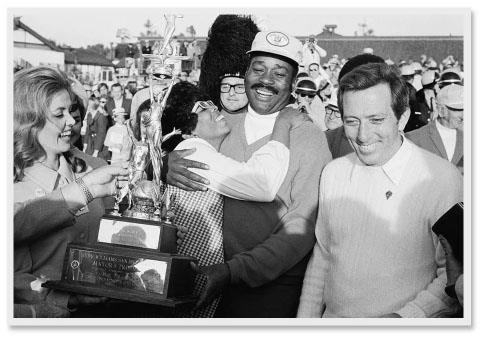 **** Brown’s rookie year in 1964 would turn out to be one of his best, as he finished 29th on the money list. He continued to play the tour with limited success. In early 1970, just before he turned 35, Brown returned to the winner’s circle for the second and final time, this time in an event with a stellar field. At the Andy Williams-San Diego Open at Torrey Pines, he beat Tony Jacklin in a sudden-death playoff. Nicklaus was one stroke back. Neither of Brown’s wins got him to Augusta. Back then, past Masters champions, by vote, could approve an invitation to a worthy player. After Brown’s win in San Diego, two past champions – Goalby and Art Wall Jr. – unsuccessfully promoted his case. Not until Lee Elder won the 1974 Monsanto Open was a Black golfer invited to play in the Masters. Not long after Brown’s win at San Diego, back injuries limited his appearances and effectiveness. Later in life, Brown suffered a series of strokes. He died on May 1, 2015, at age 80 near Augusta, Georgia, where he was living in a home owned by Jim Dent, a Black pro whom Brown had mentored. Like Sifford, Pete ended his career with two official tour victories. But while Sifford was bestowed the Presidential Medal of Freedom, Brown is largely forgotten. According to a PGA of America tribute after Brown’s death, a commentator once said during a televised event, “Here comes Pete Brown, one of the nicest men alive,” a tribute those who knew him would heartily endorse. |

 - In May 1964, golf history was made in remote Burneyville, Oklahoma at a PGA Tour event called the Waco Turner Open. The tournament ran from 1961 to 1964 at a venue then known only as “Waco Turner’s golf course,” and it combined professional golf with elements of the Wild West and Las Vegas prop betting. According to all accounts, the paucity of crowds at this event would not be seen again until the summer of 2020, when the PGA Tour resumed its schedule – without spectators – during the COVID-19 pandemic. It could well have been the strangest tour event ever staged.
- In May 1964, golf history was made in remote Burneyville, Oklahoma at a PGA Tour event called the Waco Turner Open. The tournament ran from 1961 to 1964 at a venue then known only as “Waco Turner’s golf course,” and it combined professional golf with elements of the Wild West and Las Vegas prop betting. According to all accounts, the paucity of crowds at this event would not be seen again until the summer of 2020, when the PGA Tour resumed its schedule – without spectators – during the COVID-19 pandemic. It could well have been the strangest tour event ever staged. After the war, he returned to teaching in Ardmore, Oklahoma. Turner became friendly with wildcat speculators and in the early 1920s started to invest in oil wells. Enough of them were gushers to make Turner wealthy. He eventually amassed a fortune estimated at $40 million. He and his wife, Opie, became pillars of the Ardmore community and joined the Dornick Hills Golf Club where Turner was an enthusiastic but not accomplished golfer – on a good day he could break 90 – and he also served as president of the club.
After the war, he returned to teaching in Ardmore, Oklahoma. Turner became friendly with wildcat speculators and in the early 1920s started to invest in oil wells. Enough of them were gushers to make Turner wealthy. He eventually amassed a fortune estimated at $40 million. He and his wife, Opie, became pillars of the Ardmore community and joined the Dornick Hills Golf Club where Turner was an enthusiastic but not accomplished golfer – on a good day he could break 90 – and he also served as president of the club. “It was out in the middle of absolutely nowhere, near the little town of Ardmore,” former tour pro Chuck Courtney said. “It’s right there in what’s called the Arbuckle Hills, kind of the very, very beginning of the Ozarks. Anyway, just west of there is rolling country, ranches, and oil out there, not very many miles north of the Red River, which is the Oklahoma-Texas border.”
“It was out in the middle of absolutely nowhere, near the little town of Ardmore,” former tour pro Chuck Courtney said. “It’s right there in what’s called the Arbuckle Hills, kind of the very, very beginning of the Ozarks. Anyway, just west of there is rolling country, ranches, and oil out there, not very many miles north of the Red River, which is the Oklahoma-Texas border.” In 1961, the PGA of America removed a clause in its bylaws limiting membership to Caucasians, and the PGA Tour approved the applications of eligible Black pros. This did not mean they could play everywhere. “I can compete in only about 22 of the 48 tournaments a year,” Sifford said in 1961. “I can’t play in the Southern tournaments at Houston, Baton Rouge, New Orleans and Florida.”
In 1961, the PGA of America removed a clause in its bylaws limiting membership to Caucasians, and the PGA Tour approved the applications of eligible Black pros. This did not mean they could play everywhere. “I can compete in only about 22 of the 48 tournaments a year,” Sifford said in 1961. “I can’t play in the Southern tournaments at Houston, Baton Rouge, New Orleans and Florida.” 

